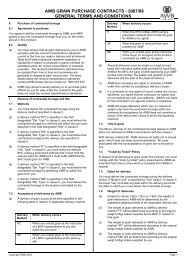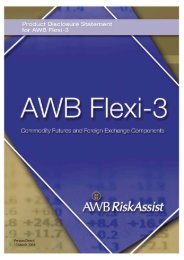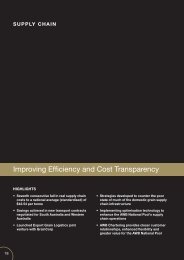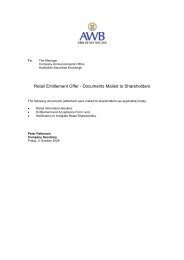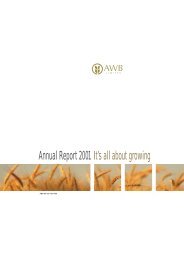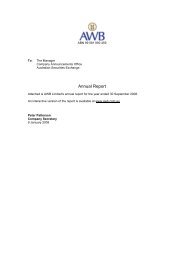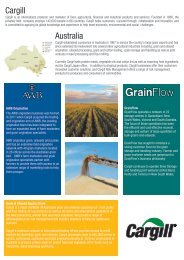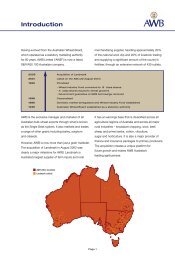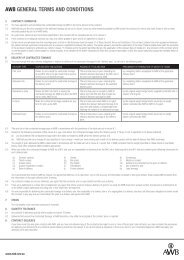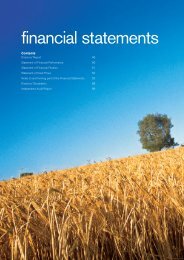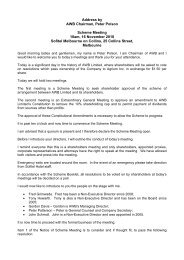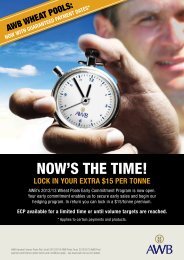AWB Limited - 2004 Annual Report
AWB Limited - 2004 Annual Report
AWB Limited - 2004 Annual Report
You also want an ePaper? Increase the reach of your titles
YUMPU automatically turns print PDFs into web optimized ePapers that Google loves.
NOTES TO AND FORMING PART OF THE FINANCIAL STATEMENTS<br />
FOR THE YEAR ENDED 30 SEPTEMBER <strong>2004</strong><br />
36. DISCLOSING THE IMPACT OF ADOPTING AASB EQUIVALENTS TO INTERNATIONAL FINANCIAL<br />
REPORTING STANDARDS (A-IFRS) (continued)<br />
(d) Inventories<br />
AASB 102 Inventories will not be applicable to the measurement of<br />
inventories held by commodity broker–traders who acquire inventories<br />
principally with the purpose of selling in the near future and generating<br />
a profit from fluctuations in price or broker–traders' margin. The<br />
inventories of commodity broker–traders will be able to be measured at<br />
fair value less costs to sell with changes in fair value less costs to sell<br />
recognised in the statement of financial performance.<br />
<strong>AWB</strong> grain acquisition and trading activities are conducted as a<br />
commodity broker–trader. The consolidated entity's current policy is to<br />
recognise grain acquisition and trading inventories at the lower of cost or<br />
net realisable value. Reliable estimation of the future financial impact is<br />
impracticable because the scale of future inventories and the conditions<br />
under which their fair value will be assessed are not yet known.<br />
(e) Financial instruments: recognition and measurement<br />
Classification of financial instruments<br />
Under AASB 139 Financial Instruments: Recognition and Measurement,<br />
financial instruments will be required to be classified into one of the<br />
following categories which will, in turn, determine the accounting<br />
treatment of the item.<br />
(i) loans and receivables– measured at amortised cost;<br />
(ii) held to maturity – measured at amortised cost;<br />
(iii) held for trading – measured at fair value with fair value changes<br />
charged to net profit or loss;<br />
(iv) available for sale – measured at fair value with fair value changes<br />
taken to equity; and<br />
(v) non–trading liabilities – measured at amortised cost.<br />
This will result in a change in the current accounting policy that does not<br />
classify financial instruments in this prescribed manner. In addition, the<br />
fair value of certain derivative financial instruments is separately disclosed<br />
(refer Note 31 (f ) Financial Instruments) but not recognised the<br />
statement of financial position. The future financial effect of this change<br />
in accounting policy is not yet known as the classification and<br />
measurement process has not yet been fully completed and the conditions<br />
under which gains or losses will be measured are not yet known.<br />
Hedge accounting<br />
Under AASB 139 Financial Instruments: Recognition and Measurement,<br />
in order to achieve a qualifying hedge the consolidated entity is required<br />
to meet the following criteria:<br />
identify the type of hedge – fair value or cash flow;<br />
identify the hedged item or transaction;<br />
identify the nature of the risk being hedged;<br />
identify the hedging instrument;<br />
demonstrate that the hedge has been and will continue to be highly<br />
effective; and<br />
document the hedging relationship, including the risk management<br />
objectives and strategy for undertaking the hedge and how<br />
effectiveness will be tested.<br />
The consolidated entity applies hedge accounting to derivatives entered<br />
into for the purpose of hedging anticipated transactions as outlined at<br />
Note 1(h). These contracts are general hedges and may not be able to be<br />
separately identified and documented in accordance with the<br />
requirements of AASB 139. Where hedge accounting will no longer be<br />
able to be applied, all gains and losses on the contracts will be recognised<br />
in the statement of financial performance. Reliable estimation of the<br />
future financial impact is impracticable because assessment of the impact<br />
of implementing the required documentation changes is yet to be<br />
completed.<br />
(f) Income taxes<br />
Under AASB 112 Income Taxes, the consolidated entity will be required<br />
to use a balance sheet liability method which focuses on the tax effects of<br />
transactions and other events that affect amounts recognised in either<br />
the statement of financial position or a tax–based statement of financial<br />
position. Under current Australian Accounting Standards, income tax<br />
losses can only be brought to account as an asset if they are considered<br />
virtually certain of realisation. AASB 112 requires income tax losses to<br />
be brought to account as an asset if they are probable of realisation.<br />
Probable is defined as more likely than not. It is not expected that there<br />
will be any material impact as a result of adoption of this standard.<br />
102



